Free Healthy Food: 6 Ways to Get Free Ingredients for Your Green Smoothies

Compared to other nutritious food choices like bottled pressed juices or prepackaged salads, green smoothies give you some of the best bang for the buck. Not only are they loaded with vitamins and minerals, but they can cost under $4 for a whole quart.
A salad or prepared juice could cost twice or even three times as much – and you may not be getting such a high level of nutrients.
While they’re already an affordable way to help you get your USDA requirements of fruits and vegetables¹ you can bring down the cost even more by finding free ingredients for green smoothies.
That’s right, FREE! With a little creativity and effort, it’s easy to find free green smoothie ingredients everywhere from your local farmers market to your own backyard, or someone else’s. Not only will you make your daily green smoothie even more affordable, but it’s also a great way to reduce your carbon footprint.
1. Don’t Waste The Leaves From Your Fruits And Veggies
While you do have to pay for the fruits and vegetables you add to your grocery basket or farmers’ market bag, you may be overlooking the bonus that comes along with your purchase: those veggies’ greens growing out of the tops of your carrots, beets, and other produce are actually great ingredients for green smoothies.
List of Edible Leaves From Vegetables and Fruits
In fact, the leaves and greens of many vegetables are edible, including what you’ll find on:
- squash
- cucumbers
- cabbage plants
- grapes
- radishes
- beets
- turnips
- strawberries
- carrots
Simply snip and rinse your veggie greens, toss them in the blender with the rest of your green smoothie ingredients, and voila! You’ve made your weekly produce run stretch even farther.
Health Benefits of Eating Fruit and Vegetable Leaf Greens
Eating the greens from the tops of your veggies has even more benefits than saving you money. Consuming a cup of leafy greens each day has been linked to slowing the rate of cognitive decline as you get older.²
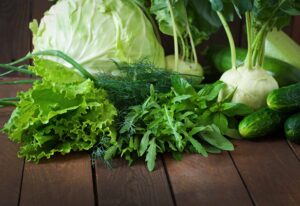
Adding a variety of greens to your daily diet will give you more energy and valued nutrients.
Plus, eating cruciferous vegetables – like kale, watercress, arugula, bok choy, collard greens, and cabbage, as well as vegetables with their own greens like radishes, rutabaga and turnips – has been associated with lower risk of cancers, including colorectal, prostate, breast, and lung cancer.³
2. Forage At The Farmer’s Market
A similar smart idea for finding free ingredients for green smoothies involves heading to your local farmers’ market to pick up the greens that vendors remove from the produce.
Many stands remove all the amazing greens from beets, turnips and carrots before they’re sold, and some stands are willing to give you those greens for free. If you’re particularly outgoing, you can even ask your fellow shoppers if you can salvage the greens they’re having removed from their own vegetables. Pay them back, with a tip about how you can blend them as a nutrient-dense green smoothie (spread the word!).
And, when you’re doing your own shopping, select fruits and vegetables from your farmers’ market that still have the greens attached. Then, keep those smoothie greens fresh by leaving them attached to your produce until you’re ready to use them. If you hit the jackpot and come home with an abundance of free smoothie greens, simply store whatever you can’t use in plastic bags in your freezer.
Try The Grocery Store For Free Vegetable Tops
If you don’t have access to a farmers’ market, some grocery stores will give you the tops of organic turnips, beets, and carrots. It doesn’t hurt to ask!
3. Find Edible Weeds And Other Wild Edible Plants
Another great way to find free green smoothies ingredients is to scavenge your community for edible weeds. Even if you don’t eat a lot of wild edibles now, this is great information to know, in times of emergency or scarcity.
Did you know the entire dandelion plant is edible? That includes roots, flowers, and everything.
In many parts of the country, weeds like dandelions and morning glory grow abundantly, and a number of them are safe – and even beneficial – to eat. In fact, many wild plants have been shown to have more nutritional value than cultivated plants4 you can find in the grocery store. So wild edibles are the exception to that old rule, “You get what you pay for!”
If you’re going to forage for edible weeds and other wild plants, I recommend that you find a reliable book like the U.S. Army’s The Illustrated Guide to Edible Wild Plants or other resources that will help you identify the weeds you’ll use in a green smoothie to be sure they’re safe. Never eat anything you can’t identify with 100% certainty.

Foraging for wild ingredients is a great way to save money and expand your diet.
Guidelines For Finding Safe Edible Weeds
- Avoid foraging in areas that have been fertilized or sprayed with pesticides. Many residents use these products to help their lawns or landscaping grow, so think twice before grabbing something from your neighbor’s yard or your community green areas.
- Stay away from areas where pets or wildlife roam freely. Pet waste and animal droppings can contaminate your edible weeds – and can be particularly dangerous if you’re eating your produce raw.
- Edible weeds tend to be best in spring. In autumn, a lot of the weeds are too tall, woody, and bitter. If you pick weeds in the heat of the late summer, look for small, tender growth.
Once you find free edible weeds for green smoothies, it’s a good idea to test each new variety to make sure it’s safe and that you won’t have a negative reaction to eating it. The U.S. Army’s The Illustrated Guide to Edible Wild Plants recommends using this method for testing a new edible plant to make sure you’ll be able to tolerate it:
How To Test If An Edible Wild Plant Is OK For You To Eat
- Rub it inside your elbow or wrist
- Put it in your mouth, but don’t chew it
- Taste a tiny piece
- Eat a larger piece
Don’t take any of these steps unless you have reason to believe the plant is edible. This is an easy and low-risk method to ensure the free weeds you identified as edible are safe and suitable for you to eat. Just take each step slowly, putting at least 15 minutes between each step, to ensure you don’t have any negative reactions.
Every part of the country has different edible plants that are suitable to the terrain and the climate. Look for edible weeds like these that commonly grow and are easy to find in many areas.
Common Edible Weeds List
- purslane
- lambsquarter
- thistle
- chickweed
- wild daylilies
- pine needles (new growth)
- oak tree leaves
- linden tree leaves
- wild dock
- wild sorrel
- chicory
- burdock
- amaranth
- grape leaves
- strawberry leaves
Best Edible Weeds For Smoothies And Salads
My favorite growing-everywhere edible weeds are these three:
1. Purslane, a high-iron, vining weed you often see in sidewalk cracks, but it's in most areas of the country, and not just in the sidewalk!

Purslane, often called pigweed, is an abundantly available edible weed.
2. Lambsquarter, which grows vertically, and unless it's too tall and woody, is mild and smooth in your blender and glass.
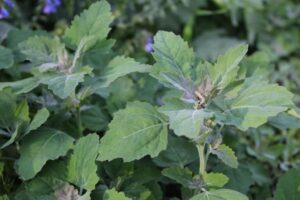
Lambs quarter is a relative of both spinach and chard.
3. Dandelion greens and flowers, highly nourishing particularly to the kidneys, and a great "bitter" to stimulate bile production in the liver.
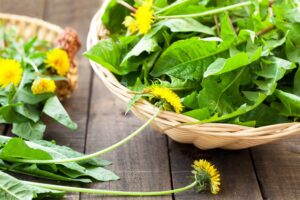
Dandelions might just seem like an annoying weed, but they're so useful in green smoothies.
4. Salvage A Garden Gone To Seed
Whether you planted seeds in your backyard but got too busy to tend to them, your neighbor abandoned the greens they started growing in a raised bed, or your community garden has become gnarled and overgrown, a garden “gone to seed” doesn’t have to be a complete waste. You may be able to salvage it as free produce for your green smoothie.
Simply get a knife or a strong pair of clippers and cut as much of the greens as you can. Don’t be timid! Even if you can barely lift your spinach plants or your chard leaves are massively overgrown, chop-chop-chop as much of the plant as you can. That includes the leaves and the woody stalks.
When you’re done, take your pile of produce into the kitchen and cram it into the blender – woody stalks and all. (Or freeze it for later--you can’t use these greens for salads, but they work in a smoothie just fine!)
Along with the rest of your green smoothie ingredients, this overgrown produce will taste just fine.
Your overgrown and untended garden could turn out to be a treasure trove of free green smoothie ingredients.
5. Glean From Fruit Trees (With Permission!)
As with untended gardens, there are many fruit trees that go unharvested or only partially harvested year after year. Get permission to glean from them, and you can pack your freezer with free green smoothie ingredients!
In the late summer in Utah, apricot trees are everywhere--and apricots are especially easy to pick, wash, bag, and freeze. I used to do this with my kids; when I saw that my neighbor’s huge tree was brimming with apricots that they weren’t picking, I’d ask if I could load up. Then, when I sold my OWN home, I went back and asked the new owner if I could have the fruit from the trees I had planted, since they’d already told me they didn’t care about it.
6. Grow Your Greens Yourself
One of the easiest ways to ensure you have free ingredients for green smoothies on an ongoing basis is to grow your own. Planting a home garden not only ensures you’ll have an abundance of green smoothie ingredients at no cost, but it’s also a great way to ensure you’re using the freshest produce possible – because you don’t have to harvest it until you need it!
There are a variety of options for creating a home garden depending upon the amount of space that’s available to you. If your home has a yard, you can either plant your garden right in the ground, or you can create raised beds in which to grow vegetables like beets, carrots, or radishes – all of which will create free greens for your green smoothies.
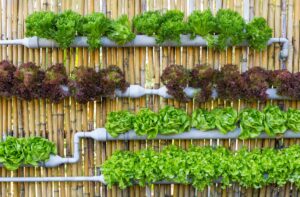
Vertical gardens are a great solution if you're low on square footage.
If you live in a condominium or an apartment, don’t worry! You still have options for planting your own garden to harvest green smoothie ingredients. Patios are perfect for creating container gardens – or you can use individual gardening pots for spinach, lettuce, and even Asian greens like bok choy. Even on a balcony, you can train many plants to grow vertically to save space.
Sprouting Seeds for Smoothie Greens
Sprouting seeds takes no soil at all, is easy to do on your countertop or windowsill, and will provide you powerful, living nutrients for very little cost. A quarter cup of a seed mix like alfalfa, clover, and fenugreek turns into a few CUPS of sprouts! I love blending sprouts into my daily green smoothie.
No matter how you grow your garden, you’re likely to find yourself with a cornucopia of fresh and free produce for green smoothies. While you may have some initial costs for seeds and soil (or Aerogarden pods or sprouting equipment), you can collect seeds from your harvest to grow next year – reducing any overhead to nearly nothing.
With so many ways to find free ingredients for green smoothies, expense will never be an excuse again! Get out there and start harvesting all the free green goodness you can find. Not only will your body reap the nutritional benefits, but your wallet will thank you as well!
Have you found free or very cheap ingredients for your green smoothies? I’d love to hear about it in the comments!
Next: Fatigue Causes You Haven't Considered But Must Address NOW
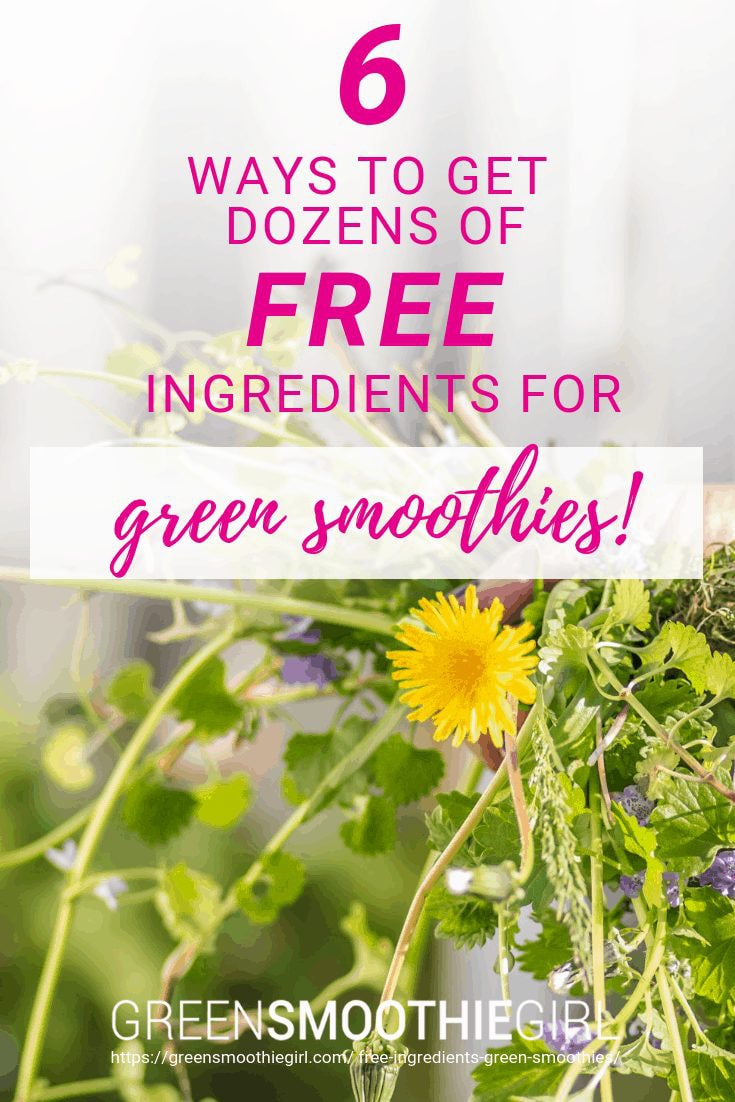
Sources
1. USDA Food and Nutrition Service “Vegetable and Fruit Requirements” Retrieved from: https://www.fns.usda.gov/cacfp/vegetable-and-fruit-requirements-child-and-adult-care-food-program-questions-and-answers
2. Morris MC, et al. Nutrients and bioactives in green leafy vegetables and cognitive decline. Neurology. 2017 90:e214-e222. Research supported by NIA grants R01 AG031553 and R01 AG17917.
3. National Cancer Institute “Cruciferous Vegetables and Cancer Prevention” Retrieved from: https://www.cancer.gov/about-cancer/causes-prevention/risk/diet/cruciferous-vegetables-fact-sheet
4. Riquelme, Javiera & Olaeta, J & Ranilla, Lena & Martinez, Pedro & Fuentealba, Claudia & Osses, Andrea & Orellana, Jaime & Gallardo, José & Pedreschi, Romina. (2016). Nutritional and functional characterization of wild and cultivated Sarcocornia neei grown in Chile. Ciencia e investigación agraria. 43. 11-11. 10.4067/S0718-16202016000200011.
Disclaimer: This article may contain affiliate links, which allows you to support our mission without costing you extra.
Posted in: Green Smoothies, Preparedness















